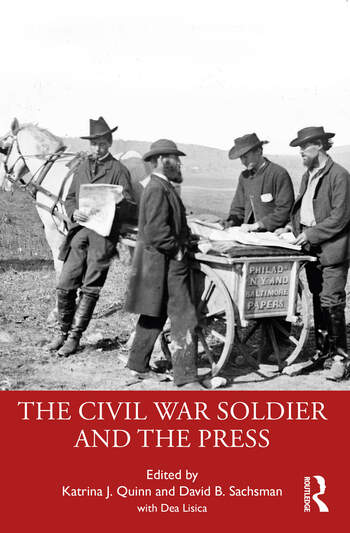Book Review: The Civil War Soldier and the Press

 The Civil War Soldier and the Press. Edited by Katrina J. Quinn and David B. Sachsman. New York: Routledge, 2023. 272 pp, softcover, $35.96; hardcover, $128.00.
The Civil War Soldier and the Press. Edited by Katrina J. Quinn and David B. Sachsman. New York: Routledge, 2023. 272 pp, softcover, $35.96; hardcover, $128.00.
Reviewed by Tim Talbott
The so-called “common soldier” of the Civil War continues to intrigue enthusiasts and inspire scholars of the conflict. The long-time subject of books written by the soldiers themselves like John D. Billings’ Hard Tack and Coffee and Carlton McCarthy’s Detailed Minutia of Soldier’s Life, and early scholarly studies like Bell Irvin Wiley’s The Life of Johnny Reb and The Life of Billy Yank, James I. “Bud” Robertson’s Soldiers Blue and Gray, and Reid Mitchell’s Civil War Soldiers, scholars are still actively examining the war through the common soldier lens.
Rather recent soldier studies have tended to focus more on specific aspects of the soldier experience than the general overviews often provided by earlier scholars. Books like Kathryn Shively’s Nature’s Civil War and Peter Carmichael’s The War for the Common Soldier look at various ways soldiers pragmatically adapted in attempt to deal with their new found lives within the ranks. Additionally, books like Dillon Carroll’s Invisible Wounds, Lorien Foote’s The Gentlemen and the Roughs, and Jonathan Steplyk’s Fighting Means Killing, all highlight specific facets that enhance our understanding of the Civil War and the soldiers who fought it.
With The Civil War Soldier and the Press, editors Katrina J. Quinn and the late David B. Sachsman, offer an excellent collection of 15 essays by 16 contributors that add to the growing pool of focused soldier-studies. These essays come from selected presentations on this theme over the years at the Symposium on the 19th Century, the Civil War, and Free Expression, previously held at the University of Tennessee at Chattanooga. By examining period newspaper stories and images from and about Civil War soldiers, the authors of these articles not only show the important relationship of the period press to the soldiers and those at home, they also offer opportunities to see how the press reported on issues like nationalism, race, gender, class, ethnicity, citizenship, disability, and death.
Co-editor Quinn provides a thought-provoking introduction that gives readers a better sense of the significance of the press to period citizens, as well as a brief preview of each of the essays to come. The editors organized the book into three parts: “Part I – Introducing the Civil War Soldier,” “Part II – Reporting the Soldier at War,” and “Part III – Commemorating and Remembering the Civil War Soldier.”
The five essays in Part I range widely. From them, readers learn about newspaper coverage of locally raised troops, visual depictions of Union soldiers in popular illustrated newspapers of the period, soldiers’ letters sent to Ohio newspapers, how the press reported women’s changing roles on the home front, and press coverage of Federal and Confederate conscription.
Part II’s six essays examine various ethnic, racial, and regional groups of soldiers as reported in the press. It is no secret that newspapers of the day often espoused a particular political party line. How a paper portrayed groups of people readily reflected those advanced by a majority of the party’s constituency. German, Irish, African American, Texas, and Mexican American soldiers all receive attention with individual essays. Also included is an additional essay exploring press coverage of prisoners of war.
Part III features four essays on soldier obituaries in newspapers, press coverage of soldier disabilities, how Century magazine’s Civil War series influenced memory of soldiers and the conflict, and newspaper reporting on Union and Confederate common soldier monuments that appeared on the landscape during the remainder of the nineteenth century.
As with any work that offers such a diversity topics (even within a themed framework), and depending on a reader’s areas of interest, they may find some of the articles more intriguing than others. However, all are well written and provide important new insights into their various subject matters. Each essay also has citation endnotes to provide readers with information about what sources the authors utilized, as well as possibilities for further learning.
The Civil War Soldier and the Press can proudly claim a worthy place alongside the finest of past and future studies about the conflict’s “common soldiers.”